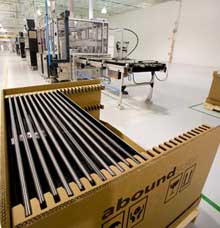Solar Cell Maker Gets a $400-Million Boost
A thin-film solar firm spun out of Colorado State University says it has developed a way to make cadmium-telluride photovoltaic modules that could be cheaper than processes used by other makers of such solar cells. Abound Solar of Loveland, CO, has received a conditional $400-million loan guarantee from the U.S. Department of Energy.

The loan will be tapped over the next three years to fund a 12-fold expansion of Abound’s capacity, bringing its total annual output to 840 megawatts and giving the company the scale it says it needs to compete with industry leader First Solar. “Abound’s device is almost identical to what First Solar makes,” says W.S. Sampath, a professor of mechanical engineering at CSU and inventor of Abound’s manufacturing process. “Our real distinction is in how we make it. It’s a more continuous in-line process. What might take five or six different machines (for another manufacturer), we do in one chamber.”
Sampath says that even though Abound produces fewer cells, its per-watt cost of production is already “quite close” to First Solar’s. “With a little more volume, we can get lower,” he says.
It’s a bold claim. Tempe, AZ-based First Solar, which currently has about 1,300 megawatts of annual production capacity and plans to add another 800 megawatts over the next two years, disclosed in its last quarter that it can produce its modules for an industry-leading 81 cents per watt.
Abound (previously AVA Solar) was founded four years ago, but its cadmium-telluride manufacturing process is based on nearly two decades of research. Two years after its 2006 spinoff from CSU, the company raised $150 million from private investors looking for a thin-film photovoltaic maker to rival First Solar.
Anders Olsson, the company’s vice-president of research and development, says all of the semiconductor manufacturing steps are integrated within a single piece of equipment. “Inside the chamber, there are many stages, but it’s all done in one vacuum envelope. There is no breaking of vacuums between steps. You put glass in and get a completed semiconductor coming out.”
He says some steps have been eliminated as a result. For example, there are no expensive and time-consuming wet chemical processes during the making of the semiconductor. And where some manufacturers lay a thicker layer of cadmium telluride and then etch back to the thinness they desire, Abound doesn’t require an etching step. “We grow the thickness we need and leave it,” says Olsson.
Abound also uses an approach to module construction that it borrowed from the dual-pane window industry. “Our product, if you think of a dual-pane window, is two pieces of glass with an air-gap in the middle, and it’s sealed around the edge with a silicone sealant and polyisobutylene,” explains Olsson. Polyisobutylene is a synthetic rubber that is impermeable to air. Such a seal protects against moisture, which can cause thin film cells to degrade.
Harin Ullal, a researcher with the National Renewable Energy Laboratory in Golden, CO, says it appears that Abound’s manufacturing process has a smaller footprint compared to First Solar and can churn out modules in less than two hours–a half-hour quicker than the cycle time claimed by First Solar. Ullal says he doesn’t think Abound risks overcrowding the market because there’s no shortage of demand. “There is room in the market,” he says.
Abound isn’t the only thin-film maker chasing First Solar. Calyxo, a subsidiary of Q-Cells that was founded in 2005, and GE subsidiary PrimeStar are among several startups also pursuing the cadmium-telluride module market.
Keep Reading
Most Popular
How scientists traced a mysterious covid case back to six toilets
When wastewater surveillance turns into a hunt for a single infected individual, the ethics get tricky.
The problem with plug-in hybrids? Their drivers.
Plug-in hybrids are often sold as a transition to EVs, but new data from Europe shows we’re still underestimating the emissions they produce.
What’s next for generative video
OpenAI's Sora has raised the bar for AI moviemaking. Here are four things to bear in mind as we wrap our heads around what's coming.
Stay connected
Get the latest updates from
MIT Technology Review
Discover special offers, top stories, upcoming events, and more.